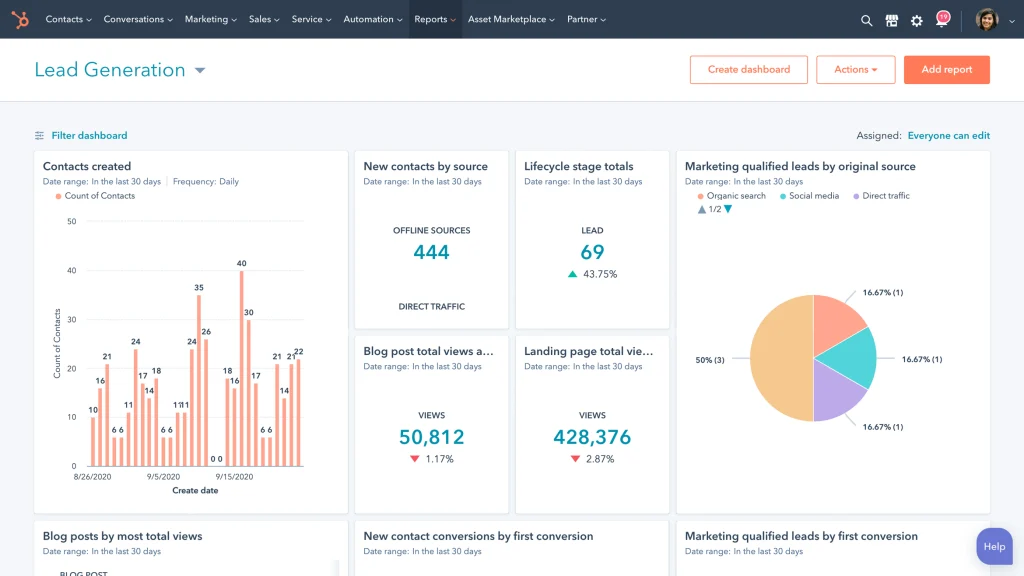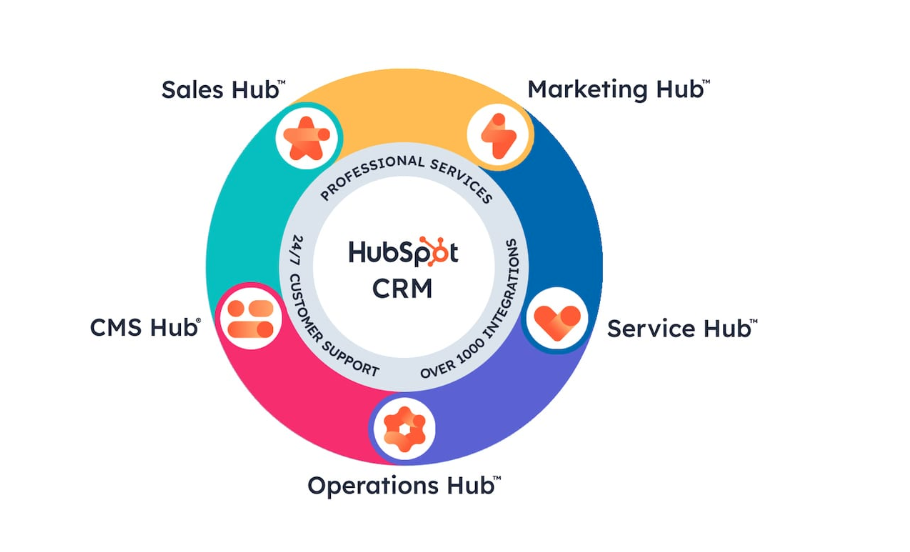
If you’re stepping into the world of inbound marketing, you’ve likely encountered HubSpot marketing. As a leader in digital marketing, HubSpot is well-known for its helpful blogs, instructional videos, and valuable certification courses. While you may be familiar with the company, grasping what the HubSpot for marketing software offers can be a bit more challenging.
The field is full of technical terms, and HubSpot’s extensive features make it hard to quickly describe what it does. As daily users of HubSpot, we’re eager to clear up any confusion and show you how HubSpot can enhance your marketing strategies.
What is HubSpot Marketing?
Imagine having all your marketing tools and data all in one place, making your role easier and saving you valuable time. That’s exactly what HubSpot Marketing Hub offers. It’s designed to streamline your marketing efforts and grow right along with your business, whether you’re a startup or scaling up.
In this blog, we’ll dive into how the Hubspot Marketing Hub helps you deliver personalised experiences that attract and convert the right customers efficiently.
HubSpot provides flexible plans to fit your needs at every stage of your journey:
- Free: $0 per month
- Starter: $45 per month
- Professional: $800 per month
- Enterprise: $3,200 per month
We’ll explore these options in more detail further on, so you can find the perfect fit for your marketing strategy.
The Five Hubspot Hub

HubSpot is organised into five distinct hubs, each designed to help with different parts of your business:
- Marketing Hub: This hub brings together all your marketing efforts, making it easier to handle everything from one place.
- Sales Hub: It smooths out your sales process, helps you manage your sales pipeline, and builds stronger customer relationships.
- Service Hub: This hub is all about making your customer service team more effective and improving how you manage customer support.
- Operations Hub: It focuses on automating data management and making it easy to customise how you handle customer data.
- CMS Hub: This hub lets you easily create a great-looking website, perfect for businesses or bloggers.
How does Hubspot work?

Let’s explore how HubSpot improves customer interactions by examining a typical customer journey. We’ll use Maria, a prospective customer, as our example:
- Discovery: Maria discovers your blog through a Google search on a topic relevant to her interests. (Marketing Hub)
- Engagement: Intrigued, she subscribes to your newsletter to learn more. (Marketing Hub)
- Tracking: HubSpot’s CRM system keeps track of Maria’s activities on your website, noting her interests and engagement level.
- Communication: Based on her interests, you send Maria targeted emails with additional resources and information. (Marketing Hub)
- Lead Conversion: Maria’s details are passed to your sales team, identifying her as a potential lead. (CRM)
- Personal Outreach: Your sales team contacts Maria through phone and email to discuss her needs and how your products can help. (Sales Hub)
- Demonstration: Maria schedules a demo to get a closer look at your products and services. (Sales Hub)
- Purchase: Maria is convinced and makes a purchase. (Sales Hub)
- Customer Support: After her purchase, Maria has questions about how the product works. (Service Hub)
- Self-service and Support: She first checks your online Knowledge Base and then connects with your Support team via live chat for further assistance. (Service Hub)
- Advocacy: Delighted with her experience, Maria shares her positive feedback online, influencing her friends who then visit your site and also make purchases.
This scenario is a perfect illustration of the inbound methodology in action. Instead of aggressively pursuing customers, inbound strategies attract them through engaging content, adding value, and nurturing relationships. This not only enhances the customer experience but also encourages organic growth and sales. Every step of the user’s journey is tracked within HubSpot, allowing your team to make friendly and timely follow-ups.
What is marketing software?
Marketing software consists of various web-based tools that help businesses reach new customers with effective marketing campaigns.
These tools handle tasks such as data collection, branding, event planning, content distribution, lead nurturing, and conversion.
How does HubSpot Marketing Hub stand out?

Unlike other software pieced together from different acquisitions, HubSpot’s Marketing Hub was built from the ground up as part of a comprehensive CRM platform, aimed to let users grow.
Here, you won’t need to manage multiple solutions or waste time merging reports because everything is integrated in one place.
The platform is both easy to use and incredibly powerful, and it supports over 1,090 custom integrations, allowing your marketing team to use all their favourite tools.
4 Marketing Challenges HubSpot Inbound Marketing Can Solve
HubSpot is known for tackling significant marketing challenges for businesses of all sizes. Let’s explore how a HubSpot can address four common issues:
- Measuring ROI
One of the biggest challenges marketers face is accurately measuring the ROI of their campaigns, particularly with social media where engagement metrics like likes and shares can be misleading. HubSpot makes it easier by allowing you to track detailed metrics for each social channel and see which ones lead to actual sales, helping you understand where to focus your efforts.
- Reaching the Right Audience
Effective content can miss the mark if it doesn’t reach the right people. This is especially crucial in paid advertising, such as Facebook ads, where targeting is key to avoiding wasted spend. HubSpot helps this with tools like LeadsBridge that sync your data with your ad campaigns to create smarter targeting lists. This includes building retargeting lists and lookalike audiences, making your advertising more precise.
- Building Credibility
Trust is crucial for attracting and keeping customers. HubSpot helps you develop a professional online presence and authoritative content that answers common questions and keeps up with industry trends. By keeping your content fresh and relevant with a well-managed content calendar, your brand stays trustworthy and reliable.
- Generating Quality Leads
It’s not just about the number of leads, but the quality that truly matters. HubSpot improves your lead generation process by tracking every touchpoint in your sales funnel, which helps you understand how best customers are found and kept. This includes focusing on keeping existing customers, since a small increase in customer retention can significantly increase profits. HubSpot supports this with targeted email marketing tools that allow for custom, mobile-friendly emails and automated follow-up emails to keep customers coming back.
These strategies not only solve specific problems but also improve your overall marketing efforts in a practical way.
What are the benefits of the HubSpot Marketing Hub?
With HubSpot, you can create engaging content that aligns with your prospects’ goals to capture their attention, convert more leads with personalised yet scalable strategies, and generate better reports through direct data translation to effective strategies and built-in custom reporting.
What are the key features of HubSpot Marketing?
- CRM for Marketing: HubSpot’s marketing products are powered by its CRM capabilities, allowing you to utilise custom objects and track customer behaviour, which is crucial for personalised marketing campaigns.
- Interactive Landing Pages: Easily customise landing pages without needing a developer, using HubSpot’s template adjustments and A/B testing capabilities.
- Email Automation: Send personalised mass emails with ease using HubSpot’s email marketing tools, which include pre-send testing on various devices and a drag-and-drop email builder.
- Social Media Management: Manage your social media effectively with tools that let you prioritise interactions and distribute content seamlessly.
- Workflows: Automate your marketing processes like lead nurturing and scoring, and personalise marketing across channels with visual workflows and bot builders.
- List Segmentation: Segment your contacts based on various criteria to tailor your marketing efforts more precisely.
- Ads Management & Retargeting: Integrate with ad networks to manage ads and build audiences directly from your HubSpot contacts, enhancing your retargeting strategies.
- Reporting Dashboard: Get detailed insights into your marketing performance with customizable dashboards that help you assess your strategies and make informed decisions.
- Live Chat: Engage visitors in real-time with live chat, supported by bots that can qualify leads and schedule meetings, enhancing your customer interactions.
- Video Management & Hosting: Integrate video into your marketing strategy by hosting and managing video content directly within HubSpot, adding CTAs, and tracking their performance.
Explore these features and more to get the most out of HubSpot, your all-in-one marketing platform that grows with your business.
HubSpot Marketing Hub Pricing
HubSpot Marketing Hub is available in three editions: Starter, Professional, and Enterprise.
Each level has a base price, and you can choose a plan that fits your business needs.
Below is a breakdown of the pricing for each edition.
| Marketing Hub Edition | Contacts | Pricing Details |
| HubSpot Marketing Hub Starter | Includes 1,000 marketing contacts, plus all non-marketing contacts are free. Total contact capacity is 15 million (marketing + non-marketing). | Starts at $50/month. Monthly pricing per 1K marketing contacts: 1-1,000: Included in your subscription of $50/mo. 1,001-3,000: Additional $50 3,001-5,000: Additional $45 5,001+: Additional $40. |
| HubSpot Marketing Hub Professional | Includes 2,000 marketing contacts. All contacts are free (marketing + non-marketing). Total contact capacity is 15 million. | Starts at $890/month. Contact us for onboarding pricing & HubSpot marketing hub setup. Monthly pricing of 5K marketing contacts: 0-2,000: Included in your annual marketing hub subscription 2,001-22,000: Additional $250 22,001 – 42,000: Additional $225 42,001 – 62,000: Additional $200 62,001 – 82,000: Additional $175 82,001+: Additional $150 |
| HubSpot Marketing Hub Enterprise | Includes 10,000 marketing contacts. Total free contact capacity is 15 Million (marketing + non-marketing). | Starts at $3,200/month. Contact us for onboarding pricing & HubSpot marketing hub setup. Annual billing. Monthly pricing per 10K marketing contacts: 0 to 10,000: Included in your annual hub subscription 10,001-50,000: Additional $100 50,001-100,000: Additional $90 100,001-200,000: Additional $80 200,001-500,000: Additional $70 500,001+: Additional $60 |
Summary
Wrapping up our deep dive into HubSpot, it’s clear why this platform is a favourite among marketers. Whether you’re just starting out or expanding your business, HubSpot has something to offer. It simplifies your marketing, boosts your sales strategy, and improves customer service – all with tools that grow with you.
Throughout this blog, we’ve shown how HubSpot can reshape your marketing efforts and help your business flourish. With flexible pricing and powerful tools, HubSpot is designed to help you attract, engage, and delight customers more effectively.
